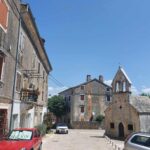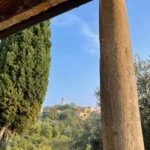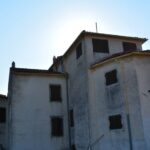Završje (also known as Piemonte d’Istria), situated on 373 elevationhill in the bosom on the Mirna River landscapes’ right bank, in Istria, Croatia is a beautiful, tranquil and picturesque. Not without reason, Završje was chosen to be home in a famous heroic outlaw Robin Hood.
Though the place that is not so far from Motovun seems to be small, it will wait for you in the serenity of their ruins, ivy and belfry at the top that is the place landmark. Završje inspired me at a glance. While driving on the road across to the town, I mentioned the beautiful place standing on the hill above. Their time seems to have stopped while entering inside. It is indeed a true design beauty, set scenically on a cliff. Made with wood and stone, Završje is undoubtedly one of Istria’s most off-the-beaten-path locations. There are ever few visitors heading there. They enjoy the ride, whatever.
Why you should visit Završje
I knew the Istrian towns are picturesque, but Završje is unique what I realized only per arrival in it. And you simply can’t imagine while visit Završje, you’re standing right in the home of a legendary heroic outlaw, famous Robin Hood. Yes, it’s right. Robin Hood (2018) ‘s best actions were recorded right here in Završje, and since Zavšje has become “rewarding” placeof art. Whether exploring the picturesque Old Završje on a guided tour or by your own, you’ll undoubtedly enjoy visiting Zavšje iconic spots from the show in real life. You probably wouldn’t be the first one to re-enact famous scenes on the site. This is by no way a prominent place. If something, then this is a town. Constructed atop a prehistoric fort and strategically significant for the Romans, its origins date back thousands of years. Medieval and, later, Venetian lords also appreciated the beauty and value of the area, constructing further fortifications.
Završje is a place takingoff a long history. Churches which are built there are evidence of the spirit. While you will walk up to the climb, you’ll feel out the breath of the past times that is in its walls. You’ll sure imagine to yourself, and only on the moment, you’ll want to have appears it back. And what kind of the bright is that had Završje once had? Here we prepared a shortlist of the things to see in Završje.
Završje in history
Learning about picturesque places is one of the best ways to feel the spirit of central Istria and to catch a glimpse of how life once looked here. Završje, known through the centuries by two names, carries a layered story worth uncovering.
The Croatian name Završje most likely comes from its position – a settlement tucked away on three sides behind surrounding hills. The older, Italian name, Piemonte d’Istria, first appeared in the early 12th century. Piemonte means “at the foot of the mountain,” and the suffix d’Istria was added to distinguish it from the region of Piemonte in northern Italy. Historical records mention the town by various forms – Pyamont, Poymont, Pemund – before settling into the names we know today.
From Lords to Empires
The first written trace dates back to 1102, when Marquis Ulrich II of Weimar donated Piemonte d’Istria to the Patriarchs of Aquileia. Through the following centuries, Završje changed hands many times: it belonged to the Counts of Pazin, came under Austrian authority in 1374, and later endured attacks during the Venetian wars against the Austrians, Hungarians, and Turks. In 1511, Venice officially took control, and by 1530 the town passed to the noble Venetian family Giustinian Contarini, who ruled it for almost three centuries. Many of Završje’s landmarks date from their era.
A Town on the Move
Napoleon’s short rule, followed by Austria and then the Kingdom of Italy, brought new rhythms to Završje. The early 20th century was a prosperous period thanks to the narrow-gauge Parenzana railway, which wound through Istria connecting small towns to Trieste. With the railway came commerce, agriculture, crafts, a post office, school, shops, even an oil mill. Završje bustled with life.
Decline and Renewal
The Second World War and the post-war, brought Završje under Croatia. Like many Istrian hilltop towns, it suffered heavy emigration for economic reasons. From nearly a thousand inhabitants, only about fifty remained. The once lively streets fell silent.
But Završje never lost its charm. Today, this medieval gem is slowly awakening again. Artists and actors from around the world have found inspiration in its stone houses and cobbled lanes. Visitors who wander here discover not only a preserved fragment of Istrian history but also a place quietly shaping a new chapter.
Završje sights
Even though it seems to be small, Završje has plenty to find out. There are few architectural highlights from its Palace,three churches, a leaning bell tower, a citadel and a southern city gate. Though all of them will be particularly given the reality of how tiny it is, the historic core of Završje is today protected urban entity. It has been proclaimed in the Register of Cultural Property of the Republic of Croatia. So let’s see what is so valuable hidden in Završje.
Visit the Church of the Nativity of the Blessed Virgin Mary
Right, when you enter in Završje what you’ll see first is the largeParish Church of the Blessed Virgin Mary’s Nativity. It is the best evidence testifying this small town’s remarkable splendour and power in the past. The late Palladian One Nave Church with an apse circular with a domed vault is located at the Završje foothill, outside the picturesqueold town’s walls. It was designed by Baroque architect Dongettia and funded by the Contarini family. The church projectwas first presented on August 3, 1792. When the church was built, the official year should be 1794, but some inscriptions were supposed to be fully completed100 years later.
To enter to it if is open and you’ll notice the richly decorated interior with the liturgical inventory, monumental sacrilege, beautiful altar paintings and the wall ceiling paintings. It is adorned with five altars and an altar dedicated to the Virgin Mary.Very unique is the image of Završje from the time when its churches were built. One of the most valuable things inside the church is organs, dating back to 1794 but were restored in 1986.
The Završje Fort
Arriving at theunder of thepeak of the hillby a stone-paved Romanic Street, located ten meters away of it, you will see an impressive building the Contarini’s Palace. You simply can’t miss it since it is one of the prominent monuments that has preserved its medieval architecture elements.
The medieval city castle was built in the 11th century and is known as the Palace of the noble Contarini. It consists of an economic part, a residential purpose, and the outbuildings surrounding the yard.It is assumed, Contarini family ruled over Zavrsje for three centuries.
See The St Mary’s Rosary Church
Just ten meters away from the Palace is situated the St Mary’s Rosary Church at the top of the hill. The church was built in 1684, and it is considered to be the Parish church until 1794.
The church interior has valuable items and fascinating works of art. There is an exciting tale regarding the lovely calyx created by “Zuanne Frintz” and donated to the Church by Pietro Funes in 1476. The calyx transferred to the Rothschild family at the end of the 18th century and is in the Louvre Museum in Paris today.
Look on to the Leaning bell tower (like in Pisa)
The sight what you should not miss while in Završje is its landmark, the leaning bell-tower. The distinctive bell tower of the St Mary’s Rosary Church is situated next to it. It is 22-metre high and what is interesting is that the bell tower is leaning40 cm to the north. Like the more famous Pisa tower in Italy, this Istrian town also has its own version of that one in Pisa.
Climb it or not by bell tower once you reach the hilltop of Završjeyou’ll have a whole practical place on your hand. However, the green Istria surroundings’ fantastic panoramic view will be better from the bell-tower because of the various surrounding buildings. But the probably best idea of Završje is that one by itself since the place is exceptionally photogenic. It seems to be a fairytale place with its bell tower, while looked down from the hill.
So you reached Završje highest point. You are all aroundthe complex of the few abandoned houses without roofs from the 16th and 18th centuries.By the fact the urban structure of Završje consists the buildings from the late Middle Ages to the 19th century they have been proclaimed of the high historical and artistic value.
Look at the dramatic look of Završje, feel the Istrian past, take a snapshot of the tower and stroll its cobblestone streets that were used to be home in a movie of Robin Hood. However, always be careful what you do, since Robin Hood is watching you!
Stroll the Contarini’s Town Gate
Walking down the hill, you’ll reach the Contarini’s town gate. Located on the south part of the town, are also known as South Gate. Built-in Romanesque style was preserved entirely since the reconstruction in 1879, and it was completely restored in 2002. On the wall above the door is the Contarini Family Coat of Arms and a Roman Relief with Ariadne and Bakho, figures from Greek and Roman mythology.
See the church of St. Rocco
The third church in Završje was dedicated to St. Rocco and is situated outside thewalls, near the town gate. The church was built in 1556 in the Gothic style and rebuilt in the 18th century,
Be active in Završje, central istria
Another noteworthy part to expiring central Istria is by hike and bike. Završe surroundings have it all, and the excellent bike path is across the Three Istrian Musketeers. One of the most famous trails next to it is old railway Parenzana.
Bike & Hike The Parenzana
Završje is already mentioned as one of the “Parenzana” 35 stationsof the former railway track that connected Trieste and Poreč. The Parenzana is an old railway line converted into a walking, biking, and cycling route. It is a good idea to take a ride or hike while you are in Završje.
Every year at the end of April, countless families, couples, groups and singles take the path of enjoying the 10-kilometre journey which takes in the stunning scenery of Istria. So you can do it as also by yourself even if you are not in Završje in the event Time.
Mountain biking to Three Istrian musketeers
Tri Istarska Mušketira Cycling Trail is a mild traffic loop route distant 43.9 kilometres. The way heads direction Oprtalj-Portole, Istria, Croatia, which has a wide woodland area, is quite challenging. The track is used mainly for mountain biking and urban bikes, and it uses a part of Parenzana.
Regardless of the starting point in Oprtalj, you can turn it on from Završje and as it is circular one finish and on the same topic.
Daily tours from Završje
Similar to the other Istrian hills, including and those Završje is boundedthat are not far away, such as Oprtalj, Zrenj, Buzet, Motovun, Zamask,etc. Završje is very often spotted by daily tours as itself. However, every year, more visitors decide to choose central Istrian Gems as Završje for their holiday since those are quite in green area and surroundings. If you do, readin our blog post, about theThings should make to feel Istria, to see the daily tours from Završje.
Hidden in the hills of northern Istria, Završje might feel remote, but reaching it is easier than it seems. Here are the main ways to get there:
✈️ By Air. Several airports connect Istria with the rest of Europe:
- Pula Airport – About 90 km away (1.5 hours by car). Pula is the main gateway to Istria and Croatia’s fourth busiest airport.
- Rijeka Airport (Krk Island) – Around 105 km from Završje (about 2 hours’ drive). Popular with low-cost airlines in summer.
- Trieste Airport (Italy) – About 100 km away, just over the border, above Monfalcone.
- Venice Marco Polo Airport (Italy) – 240 km away (roughly 3.5 hours’ drive). A good option if combining Italy and Croatia.
- Zagreb Airport – Croatia’s largest airport, 250 km away (about 3.5 hours’ drive).
🚌 By Bus. Public transport in Istria is reliable along the coast but less frequent inland. Buses to Završje are limited and primarily serve locals—so check schedules carefully, and be ready for a bit of adventure.
🚆 By Train. The nearest stations are in Buzet (30 km) or Koper (Slovenia). From there, you’ll need a taxi or private transfer, as train links to central Istria are limited.
🚗 By Car. The most convenient way to reach Završje is by car. Roads in Istria are well maintained and scenic, making the journey part of the experience. Renting a car is highly recommended if you want the freedom to explore nearby villages, vineyards, and hilltops at your own pace.
🅿️ Parking. Cars are not allowed inside Završje’s historic core. Parking is available at several spots near the town entrance, with the main one located in front of the Parish Church. From there, it’s a short walk into the medieval streets.
Distances:
- Završje – Rovinj: 72 km
- Završje – Poreč: 40 km
- Završje – Novigrad: 33 km
Završje is undoubtedly one of Istria’s hidden gems, having preserved its old-world charm. It’s a must-visit while exploring central Istria. I personally recommend it as one of the top places to stop by in the area.
What to do in Završje tip: Don’t forget to take a photo of the entire village, as it offers a perfect view for a memorable picture. But even more importantly, you should taste the delicious Istrian specialties like prosciutto, cheese, olive oil, wine, truffle dishes, and homemade pasta at one of the rural households nearby.



